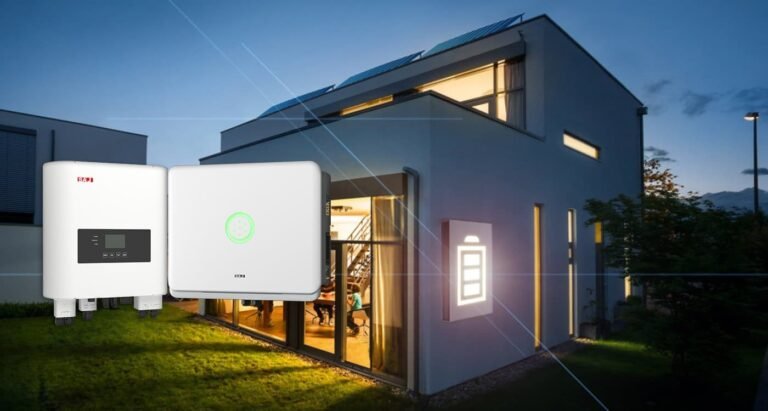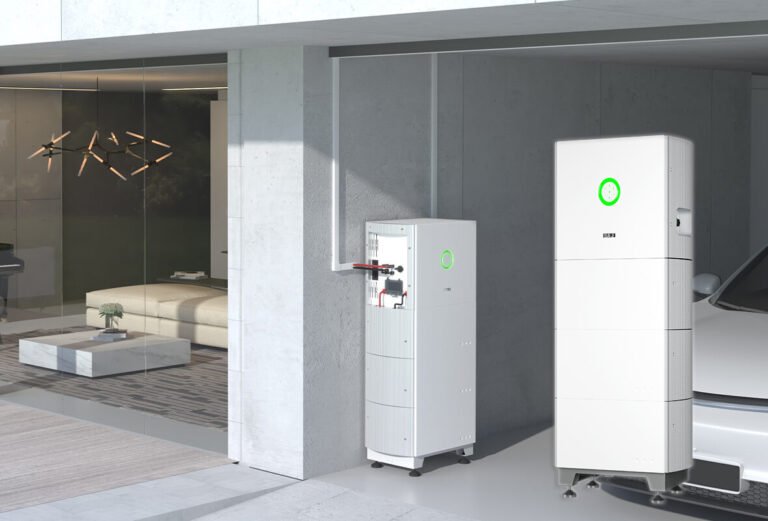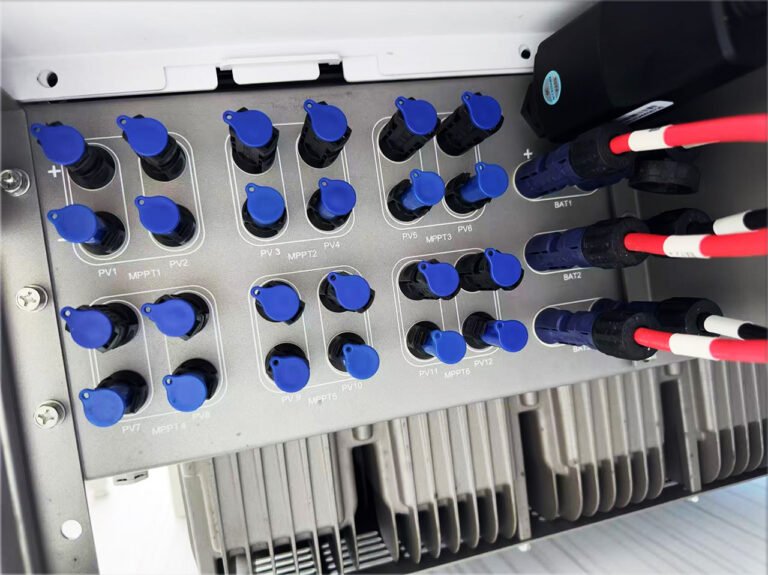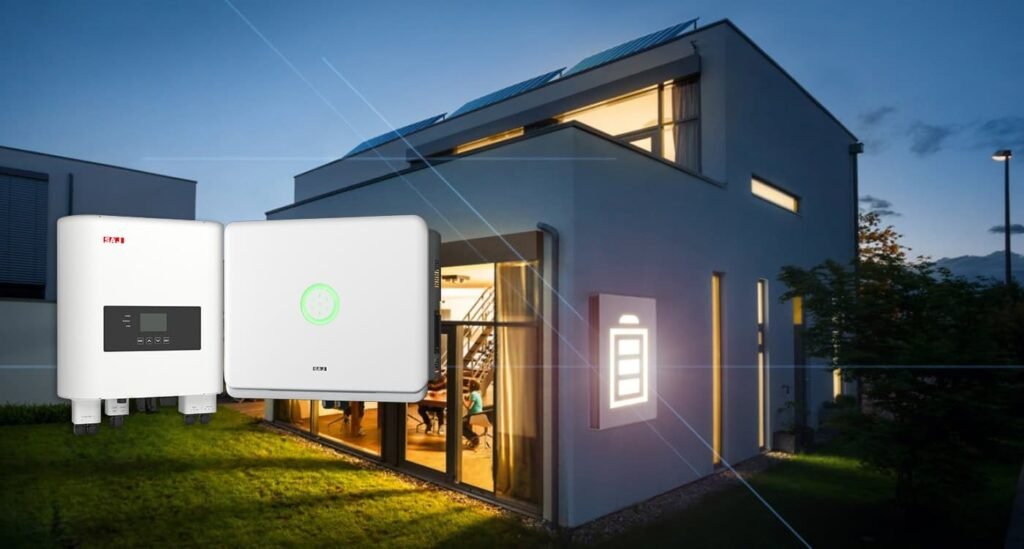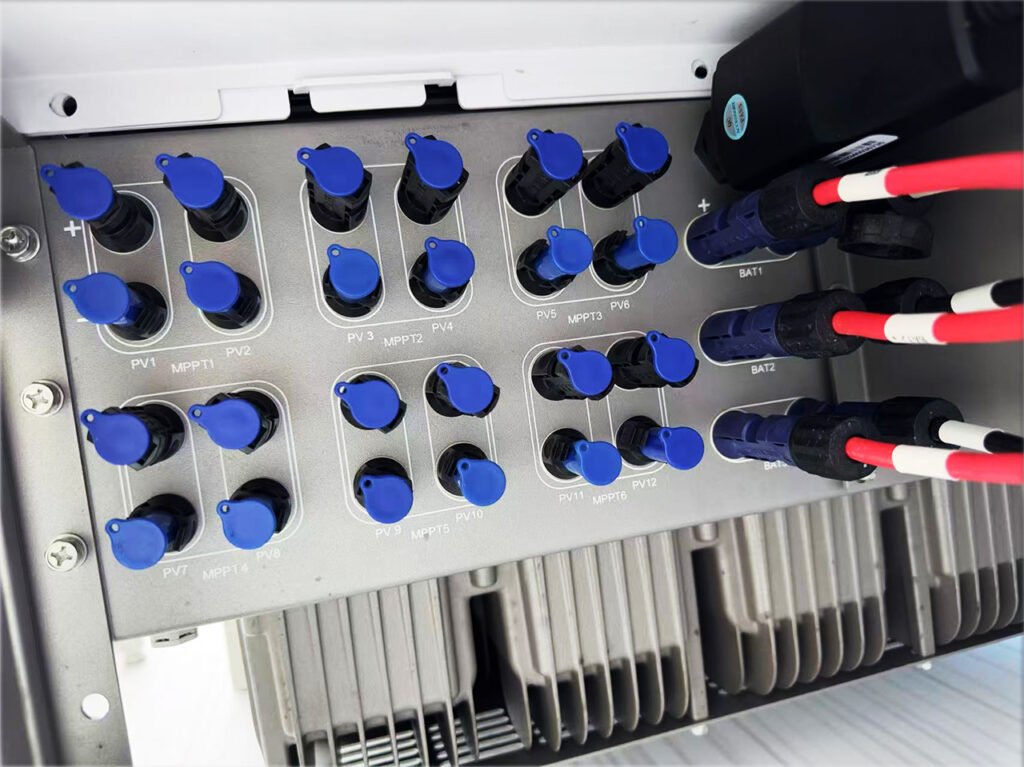Want to shrink those energy bills and tap into clean solar power? An on-grid inverter could be your secret weapon. It’s designed to help you save money and use energy smarter, and understanding it doesn’t have to be complicated!
Think of an on-grid inverter as the brain of your solar setup: it turns sunshine into usable power for your home and helps you share any extra with the grid.

Sounds pretty good, right? But how does it actually work for you in a way that makes sense? Let’s explore how this clever device can lead to real savings and a bit more energy freedom, in plain English.
What Is an On-Grid Inverter? Its Core Function Explained
Basically, an on-grid inverter takes the raw solar energy your panels collect (DC power) and changes it into the type of power (AC power) that your home appliances and the utility grid use.
Ever wondered how sunlight magically turns into the power that runs your coffee maker or TV? Well, it’s not exactly magic, but there’s a key piece of tech doing the heavy lifting: your on-grid inverter. Think of it as the quiet, hardworking hero of your solar system.
From Sunshine to Socket: The Simple Story
Here’s what happens, in a nutshell:
- Panels Catch the Rays: Your solar panels soak up sunshine and create a type of electricity called Direct Current (DC). This is like the raw, unrefined power.
- The Inverter’s Smart Switch: Now, most things in your home prefer a different "flavor" of electricity called Alternating Current (AC). The on-grid inverter’s main job is to take that DC power from the panels and neatly convert it into the AC power your house loves.It’s like a skilled translator making sure everyone speaks the same language.
- Powering Your Life: This fresh AC power then flows right into your home, running your lights, charging your phone, and keeping everything humming.
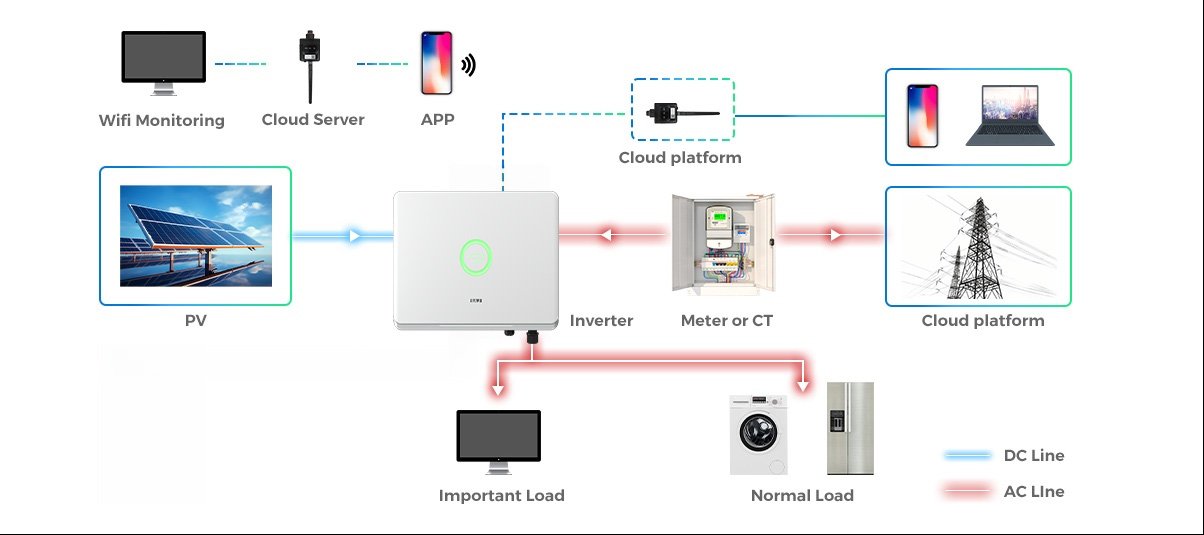
What About Extra Power or Cloudy Days?
Here’s where it gets even smarter:
- Sharing is Caring (and Rewarding!): If your panels are making more electricity than you need at that moment, the inverter doesn’t just let it disappear. It cleverly sends that extra power out to the public grid.
- Grid Love: Depending on where you live, the utility company might even give you credits on your bill or pay you for that power. Nice, right?
- Always On: And when the sun takes a break (like at night or on a super cloudy day)? No worries. The system automatically and smoothly pulls power from the grid, so you’re never left in the dark.
It’s all about making your energy use seamless and efficient, without you having to think about it.
Why On-Grid Inverters Are Key to Your Solar Success
When you’re planning a solar setup, it’s easy to get excited about the panels. But here’s a friendly tip: paying close attention to your inverter choice can be the difference between a good solar system and a great one that truly pays off.
A quality on-grid inverter is your ticket to getting the most out of your solar panels. It works hard to maximize your energy generation, keeps your system running reliably, and ultimately means more money in your pocket and less hassle for you.
A good inverter isn’t just a box that sits there; it’s actively working to get every bit of usable power from your panels. So, how does this actually help you?
Getting More Bang for Your Buck: A Smart Sizing Tip
One of the questions people often ask is about the "right size" for their inverter. It’s a bit of a balancing act, but there’s a strategy called DC oversizing that many find really boosts their system’s output without costing a fortune. It just means having a bit more solar panel capacity (DC) than your inverter’s power rating (AC).
A Little "Secret" for More Energy: Think of sensible DC oversizing as an affordable way to get more kilowatt-hours from your system. Real-world experiences show that even if your panels can produce a bit more than the inverter can handle on the absolute sunniest hour of the year (this is called "clipping"), the extra energy you gain on all the other days often adds up to a noticeable boost – maybe around 5% more energy annually with a setup that’s about 35% oversized on the DC side. And the best part? The inverter itself is usually only a small slice of the total system cost.
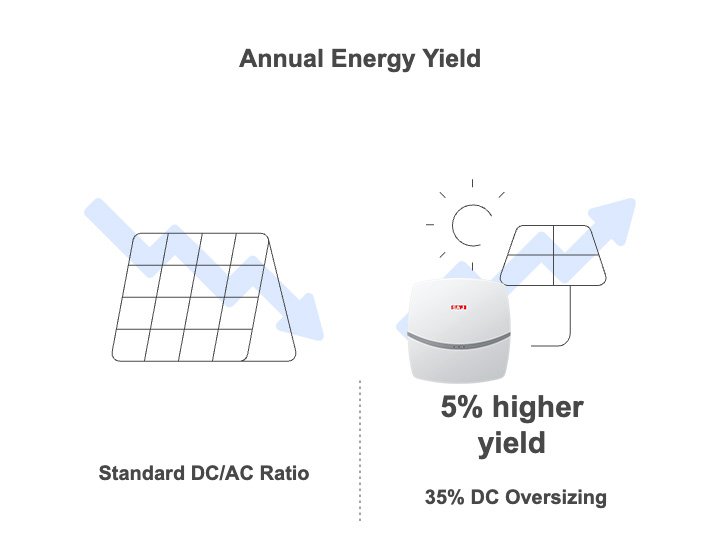
Keeping Things Running Smoothly (and Saving on Headaches)
What about checking up on your system or if a little gremlin appears? Modern inverters are impressively smart and often come with ways to keep an eye on things easily.
Smart Monitoring for Peace of Mind: Imagine being able to see how your solar system is doing with a quick glance at an app, or getting an alert if something needs attention before it becomes a big deal. That’s what remote IoT (Internet of Things) monitoring offers.
- Quick Fixes: Instead of waiting for a technician and a potentially long site visit, many small issues can be spotted and even sorted out remotely, often in less than an hour.
- Real Savings, Less Stress: This isn’t just about convenience. It can save real money (think €70-€90 per inverter, per year, in avoided call-out fees and lost energy). Over the years, that adds up! It turns system care from a potential worry into something that actively protects your investment and keeps the green energy (and savings) flowing.
So, you see, the inverter is much more than just a piece of hardware. It’s a vital player in how efficient, reliable, and ultimately rewarding your solar journey will be.
How On-Grid Inverters Power Your Home from the Sun
Your on-grid inverter takes the DC power from your solar panels, converts it to AC for your home, and smartly sends any extra electricity to the grid so it doesn’t go to waste.
It’s a cool, automated process that brings the power of the sun right into your home, making your daily life a bit greener and cheaper. Here’s how that energy flows:
- Sun Shines, Panels Work: Your solar panels on the roof catch the sun’s rays and get busy making DC electricity.
- Inverter Does its Thing: This DC power travels to your on-grid inverter. The inverter’s big job is to change this into the standard AC electricity that all your home appliances use.
- Powering Your Home: This fresh AC power is used first by anything in your house that’s switched on – lights, fridge, computer, you name it.
- Sharing the Extra: If your panels are making more power than you’re using right then, the inverter doesn’t let it go to waste. It cleverly sends the surplus out to the public utility grid.
- Grid as a Friend: And if it’s nighttime or a really gloomy day and your panels aren’t producing much? No problem. Your home just automatically and smoothly draws power from the grid like it always has.

It’s also good to know that safety and compliance are built-in. Features like Arc Fault Circuit Interrupter (AFCI) provide an extra layer of safety against electrical faults. Plus, being able to precisely control power export helps meet grid codes (like VDE-AR-N 4105 in Germany or EN 50549 in Europe). This isn’t just about following rules; it can make getting your system approved much smoother and sometimes even help you qualify for better financing for your solar project.
So, your inverter is like a smart, silent energy manager, always working to optimize your power, keep things safe, and make sure everything is in order.
Top Benefits of Using Quality On-Grid Solar Inverters
Okay, you get that a good inverter is a big deal. But what are the actual, real-world perks that make choosing a quality on-grid inverter a smart move for you and your home?
A quality on-grid inverter means lower energy bills, making the most of every sunbeam for better efficiency, and a more reliable system. Plus, you’re doing your bit for the planet and potentially boosting your home’s value.
Let’s unwrap these benefits:

Here’s a bit more on what makes these so great:
Smaller Energy Bills (The Big One!):
This is usually why most people get excited about solar. Using your own free sunshine means you buy a lot less electricity from the utility company. That can add up to some serious savings on your monthly bills! And in some places, if you send extra power to the grid, you might even get credits or cash back.Getting the Most from Your Sunshine (Better Efficiency):
Quality inverters are simply better at their job of changing DC to AC without losing much energy in the process. Top-notch ones, like some of SAJ’s R5 series, can be over 98% efficient.More efficiency means more of your hard-earned solar energy actually powers your life.Remember that DC oversizing tip? A high-efficiency inverter is what makes that strategy really sing, ensuring you capture and use as much energy as possible.
A System You Can Count On (Less Hassle):
Generally, better quality means better parts and smarter design. This usually translates to an inverter that’s less likely to give you trouble and should keep working well for longer. Fewer unexpected repair calls mean less stress for you. Plus, with good remote monitoring (like SAJ’s eSolar platform), you often get peace of mind knowing you can easily check in on your system, and many small issues can be spotted or even fixed remotely.Doing Your Bit for the Planet:
It just feels good to know you’re using clean, renewable energy and reducing your carbon footprint. Every solar system helps!A Nice Boost to Your Home’s Appeal:
Homes with solar panels are often seen as a plus by potential buyers. It can make your property stand out and might even increase its value.Making the Most of Incentives:
Many areas offer tax breaks, rebates, or other perks for going solar. A good, efficient system helps you get the maximum benefit from these programs.
Essential Features: Choosing Your Ideal On-Grid Inverter
Alright, you’re on board with the benefits. But when you start looking at different inverters, the tech specs can seem a bit like a foreign language. So, what should you really look for to make sure you pick an inverter that’s a great fit for your home and your needs, without getting lost in the jargon?
To pick your ideal on-grid inverter, look for the right power size, great efficiency, enough MPPTs for your roof, good monitoring, and all the key safety papers. These help ensure it works well and reliably for you.
Let’s break down these essential features into more understandable chunks:
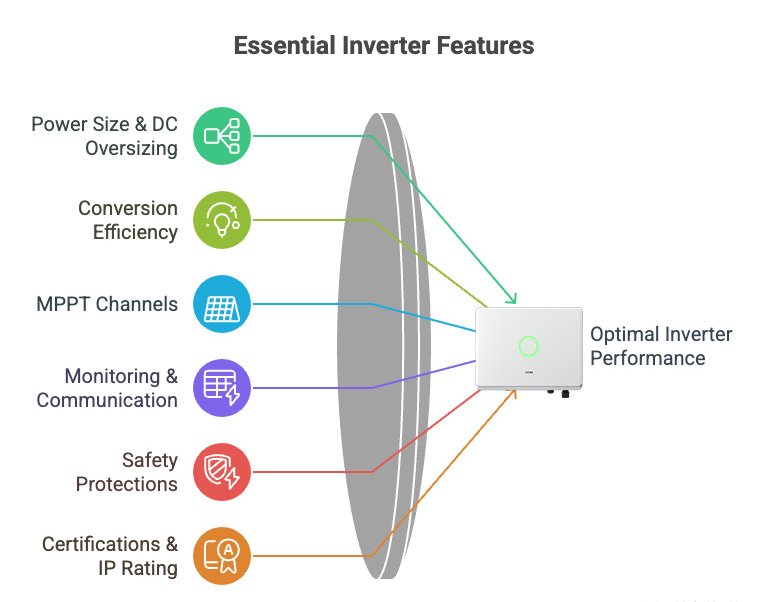
Core Performance and Design
Power Size (Rated Power) and Room for "Extra" Panels (DC Oversizing):
- The inverter needs to be a good match for the amount of power your solar panels can produce.
- Also, ask about "DC oversizing." This means the inverter can handle a bit more panel capacity than its official rating. Why is this good? Because it often means you capture more energy overall, especially on days that aren’t blazing sunshine from dawn till dusk.
- It’s worth asking your installer: “How can we design this system to really make the most of all the sunlight we get, not just on perfect days?”
Efficiency (How Much Sunshine Becomes Usable Power):
- Look for a high percentage here. The closer to 100%, the less energy is wasted when converting from solar DC to home AC. Good ones are often above 98%.
- MPPTs (Making the Most of Tricky Roofs):
- If your roof isn’t a simple, flat surface facing the perfect direction, or if parts of it get shaded, you’ll want an inverter with "Multiple Power Point Trackers" (MPPTs).
- Think of each MPPT as a mini-optimizer for a section of your panels. More MPPTs mean more flexibility to get the best performance from different parts of your roof.
- This is especially helpful with today’s very powerful solar panels (700W+). It can even save money on extra wiring and boxes for complex setups.
Staying Connected and Safe
- Matching Your Panels (Input Specs):
- The inverter needs to be a good electrical match for your specific solar panels. Your installer will handle this, but it’s good to know they’re compatible.
- Keeping an Eye on Things (Monitoring & Communication):
- You’ll want to see how much power your system is making! Look for easy ways to connect, like Wi-Fi, and an app or website (like SAJ’s eSolar Portal) to check performance.
- All-Important Safety Features:
- This is key. Your inverter should have built-in protection against things like power surges, electrical faults (over/under voltage, short circuits), and it should check for insulation problems.
- Ask about an "Arc Fault Circuit Interrupter" (AFCI) – it’s an important fire safety feature.
- It also needs the right controls to work safely with the grid, like "zero-export" if your local rules require it. These aren’t just for safety; they’re often needed to get your system approved.
Built to Last and Officially Approved
- Official Stamps of Approval (Certifications):
- Make sure the inverter has the right certifications for your country and region (like CE, VDE, EN50549). This means it’s been tested and meets safety and performance standards.
- Weatherproofing (IP Rating):
- If your inverter is going to be outside, it needs to be tough enough to handle the weather. An "IP65" rating is usually a good sign for outdoor use.
- A Good Name and Backup (Brand & Warranty):
- It’s generally wise to go with a brand that has a good reputation and offers a solid warranty. This is your peace of mind if anything needs fixing down the line.
Avoid These Mistakes When Picking an On-Grid Inverter
Choosing an on-grid inverter is a pretty big decision for your solar setup, and like any big decision, there are a few common slip-ups that can lead to disappointment (and maybe cost you money or energy!). Knowing what to watch out for can help you make a smarter choice.
Common mistakes include getting the size wrong, not considering your specific roof, or skipping over important checks like certifications and how easy it is to monitor. Also, don’t get caught out by unreliable suppliers – that can really spoil your solar plans.
So, what are these potential tripwires?
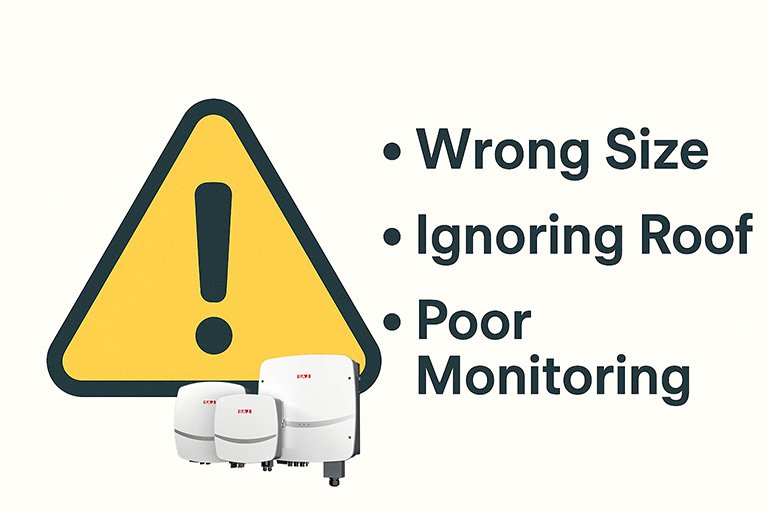
1. Sizing Oopsies (Too Big or Too Small)
Getting the inverter size right is crucial, and it’s not always straightforward:
- Going Too Small: If your inverter is undersized for your solar panels, it’ll often get overwhelmed on sunny days. This means it can’t convert all the power your panels are making, so that extra energy just gets wasted (this is called "clipping"). That’s like leaving free money on the table!
- Going Way Too Big (Without a Plan): While a little "DC oversizing" (more panel capacity than inverter rating) can be smart, just buying a massively oversized inverter without a good reason might mean you’ve spent more than you needed to.It’s often helpful to think of *strategic* DC oversizing as a kind of “cheap energy insurance.” You might lose a tiny bit of power on the absolute sunniest days if the inverter hits its max, but you’ll likely gain much more energy overall during all the other times.
2. Forgetting Your Roof’s Unique Quirks
Not every roof is a simple, perfectly angled rectangle:
- Shady Spots or Multiple Angles: If you have parts of your roof that face different directions, or if trees or a chimney casts shadows at certain times of day, a basic inverter with only one "brain" (MPPT) for all your panels will really struggle. Some panels will drag down the performance of others.
- The Smarter Fix: For these more complex "tricky" roofs, inverters with several MPPTs are a lifesaver. Each MPPT can optimize a different section of your panels independently. This means you get the most possible power, and it can even make the installation simpler and sometimes cheaper by reducing the need for extra bits of kit. Always ask: "Is this inverter a good match for the actual shape and conditions of my roof?"
3. Skimping on Monitoring & Easy Maintenance
An inverter without a good, easy way to see what it’s doing can leave you guessing:
- Flying Blind: If you can’t easily check your system’s performance, you might not even know if something isn’t working quite right, meaning you could be losing out on energy and savings.
- Troubleshooting Headaches: If a problem does pop up, figuring it out can be a slow and frustrating process without good diagnostic tools, often meaning a costly call-out.
- The Value of Insight: Modern cloud-based monitoring isn’t just a cool gadget; it’s a really practical way to look after your investment. Being able to see how your system is performing, get alerts if something is off, and even have some issues checked or fixed remotely can save a lot of hassle and protect your savings.
4. Ignoring the Paperwork (Certifications & Local Rules)
This might seem boring, but it can stop your project in its tracks:
- Grid Connection Problems: If an inverter isn’t officially certified for your area or doesn’t meet the local utility company’s rules, they might simply refuse to let you connect it to the grid.
- Safety First: Non-compliant equipment can also be a safety concern.
- Financing & Perks: Having the right safety features (like AFCI for fire prevention) and the correct controls for interacting with the grid are often essential for getting your system approved. They can even affect whether you qualify for certain green loans or incentives. It’s really important to make sure all the local requirements are covered before you buy.
5. Choosing Price Over Peace of Mind (Supplier & Brand Reliability)
It can be tempting to go for the cheapest option, but this can be a false economy with inverters:
- Quality Questions: An unknown brand or an unreliable supplier might mean you end up with a product that has quality issues, doesn’t perform as advertised, or breaks down prematurely.
- Support Struggles: You might also face unreliable delivery or find there’s no real help available if you need technical support or have a warranty claim later on.
- Thinking Long-Term: Especially now, with more focus on where products come from and how they’re made (ESG factors), it’s wise to choose established brands with clear supply chains and good local support. It helps avoid nasty surprises and gives you more confidence in your long-term investment.
SAJ On-Grid Inverters: Powering Your Solar Projects Reliably
So, when you start looking at specific brands to bring your solar dreams to life, you’ll want to know if they’re a solid choice that will perform well for years to come. How does a brand like SAJ stack up when you’re thinking about all this?
SAJ on-grid inverters are designed to be a trustworthy heart for your solar system, offering a good mix of high efficiency, design flexibility for different roofs, and smart ways to keep an eye on performance.
Based on what they offer, and keeping in mind what makes for a good, hardworking inverter, here’s how SAJ solutions can meet those key needs we’ve been discussing:
| SAJ Series | Max Efficiency | MPPTs (Typical) | Key Highlight |
|---|---|---|---|
| R5 (1-ph) | Up to 98.6% | 1-2 | Compact, High-Efficiency Residential |
| R6 (3-ph) | Up to 98.6% | 2-4 | Versatile for C&I, Multi-MPPT |
| C6 (3-ph) | Up to 99.0% | Up to 10/12 | Utility-scale, Max Yield |
Key Advantages You Might Find with SAJ Inverters
- Getting the Most from Your Sunshine (High Efficiency):
- SAJ inverters, like their R5 and R6 series, are built to be very efficient (often up to 98.6%). What this means for you is that more of the DC power your panels generate is successfully turned into usable AC electricity, with less energy wasted.
- They’re generally designed to work well with today’s powerful solar modules and often support those smart DC oversizing strategies we talked about, helping you capture as much energy as possible.
- Handling All Kinds of Roofs (Flexible Design):
- SAJ usually offers a good range of inverter sizes, so whether you have a small home system or a larger commercial one, there’s likely an option.
- Many of their series, especially for larger systems like the R6 three-phase, come with multiple MPPTs (those ‘mini-optimizers’ for different roof sections).
- This kind of flexibility, with multiple MPPTs and the ability to handle good current from the panels, is a real advantage, especially if your roof isn’t perfectly simple. It means installers can often design a more efficient system, sometimes even saving money on extra components and making the job quicker.
- Easy Peasy Monitoring (Smart & User-Friendly):
- SAJ typically provides access to their eSolar cloud monitoring platform. This usually means you can check on your system’s performance from a webpage or a mobile app.
- You can see how much power you’re making in real-time, change settings if needed, and even help get any issues diagnosed remotely.
- For anyone with a solar system, keeping it running smoothly with minimal fuss is a big win. This kind of easy-to-use monitoring can be really valuable for cutting down on maintenance worries and costs.
- Keeping Your System Safe (Comprehensive Protection):
- Good inverters come with a range of built-in safety features, and SAJ is no exception. They typically include protection against common electrical problems like power surges, over or under voltage, and leakage currents.
- Features like an Arc Fault Circuit Interrupter (AFCI), which is an important fire safety device, are often available or standard.
- Plus, their products generally carry international certifications, showing they meet important safety and grid connection rules in many parts of the world. Knowing your inverter has these protections and approvals gives you peace of mind.
- A Name You Can Look Up (Brand & Supply):
- Choosing an established brand like SAJ, especially when you buy through official, authorized channels (like Sunriver Electric), helps make sure you’re getting a genuine product.
- A reliable supply chain and good local support are also really important if you need technical help or have a warranty question down the line. In today’s world, knowing where your products come from and that you can trust the supply is a big deal for long-term confidence.
Of course, picking the exact SAJ inverter that’s perfect for you will always depend on a careful look at your specific project size, your roof, and your budget, ideally with advice from a good installer.
Conclusion
So, there you have it. On-grid inverters are a really important part of any solar power system. Getting the right one can mean real savings and efficient, clean energy for you.
Remember to look for good efficiency, the right features for your roof (like MPPTs), easy monitoring, and a trustworthy brand.
That’s your path to solar success!



